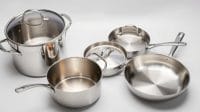Choosing between stainless steel and carbon steel can be tough. They serve different needs in construction, manufacturing, and cooking. This guide helps you understand the key differences between them.
Stainless steel is great because it doesn’t rust and looks good. It’s perfect for medical tools and kitchen items. On the other hand, carbon steel is strong and durable. It’s best for making sharp tools.
Knowing the strengths of stainless steel and carbon steel helps you make better choices. This article will look at their properties, uses, and costs. It aims to help you pick the right material for your needs.
Introduction to Steel Types
Knowing about the different steel types is key for smart choices in building, making things, and more. Carbon steel and stainless steel are the two big ones. They each have their own strengths and uses, making it hard to pick the right one.
Carbon steel is mostly iron with a bit of carbon, from 0.15% to 3.4%. It comes in types like low-carbon, medium-carbon, high-carbon, and ultra-high carbon. Its strength and toughness make it great for building and heavy machines.
Stainless steel, on the other hand, has at least 10.5% chromium. This gives it amazing resistance to rust. It’s perfect for places where keeping things clean is important, like in hospitals and food factories. There are many grades of stainless steel, each for different needs.
Choosing between carbon steel vs stainless steel depends on what your project needs. You have to think about strength, how well it resists rust, and what it’s for. For more info on these steels, check out this guide.
| Steel Type | Composition | Key Properties | Common Uses |
|---|---|---|---|
| Carbon Steel | Iron + 0.15% to 3.4% Carbon | Strong, hard, less corrosion resistant | Construction, heavy machinery |
| Stainless Steel | Iron + min. 10.5% Chromium | Corrosion resistant, durable | Medical equipment, food processing |
What Is Carbon Steel?
Carbon steel is a mix of iron and carbon. It has up to 2.1% carbon by weight. This affects its strength, flexibility, and hardness. It’s used in many places because it’s strong.
Definition and Composition
Carbon steel’s carbon content is key to its properties. The American Iron and Steel Institute (AISI) sets rules for it. These include limits on copper and silicon. This makes carbon steel strong and hard, perfect for building and making things.
Types of Carbon Steel
There are different types of carbon steel:
- Low-Carbon Steel (up to 0.25% carbon): It’s soft and easy to shape and weld.
- Medium-Carbon Steel (0.25% – 0.6% carbon): It’s strong and flexible, good for building things.
- High-Carbon Steel (0.6% – 1.25% carbon): It’s hard and used in tools and heavy parts.
- Ultra-High Carbon Steel (1.25% – 2.1% carbon): It’s very hard and strong, used in special jobs.
Properties of Carbon Steel
Carbon steel’s properties change with its carbon content. This makes it useful in many ways:
- Strength: It’s stronger than stainless steel, great for tools and machines.
- Durability: Its high carbon makes it tough, needed for hard jobs.
- Corrosion Sensitivity: It can rust if wet, so it needs care.
In short, carbon steel is special because of its types and properties. It’s used in building and making things. For more on carbon steel, check out this resource.
What Is Stainless Steel?
Stainless steel is a big step forward in making metals. It’s known for being tough against corrosion and looking great. It’s mostly iron with at least 10.5% chromium. The chromium creates a protective layer that stops rust.
Definition and Composition
Stainless steel also has other metals like nickel, manganese, and molybdenum. These add to its strength, flexibility, and ability to fight corrosion. This makes stainless steel perfect for many uses, like in cars and planes.
Types of Stainless Steel
Stainless steel comes in different types, each with its own special traits and uses:
- Austenitic: Makes up most of stainless steel. It’s great at fighting corrosion and bending easily.
- Ferritic: Used in things like washing machines and building parts. It’s good at handling stress.
- Martensitic: Often used for knives and turbine blades. It’s strong and hard.
- Duplex: Has twice the strength of austenitic stainless steel. It’s used in shipbuilding and oil work.
- Precipitation-hardening: It’s strong and fights corrosion well. It’s used where both are needed.
Properties of Stainless Steel
The stainless steel properties that make it useful include:
- Corrosion Resistance: It does well in tough places, avoiding rust.
- Strength and Durability: It’s stronger than many metals, lasting longer in many uses.
- Aesthetic Appeal: Its shiny look and ability to stay that way add to its beauty in design.
Key Characteristics of Stainless Steel
Stainless steel is very popular in many industries because of its great qualities. It’s tough and easy to care for. This makes it a top choice for places like food processing and medical equipment. Its standout features, especially in fighting corrosion, are key.
Corrosion Resistance
Many industries choose stainless steel for its corrosion resistance. This is because of chromium, which creates a protective layer. This layer stops rust and keeps stainless steel working well in wet or acidic places, making it last longer.
Strength and Durability
Stainless steel is also known for its strength and durability. It can handle a lot of impact and stress. This makes it perfect for demanding jobs, like in medical devices and kitchen tools. It stays strong even in tough conditions.
Aesthetic Appeal
Stainless steel also looks great, adding to its appeal. Its shiny surface gives a modern and sleek look. This is why it’s used in architecture and kitchen appliances. It stays shiny with little care, making it perfect for homes and businesses.
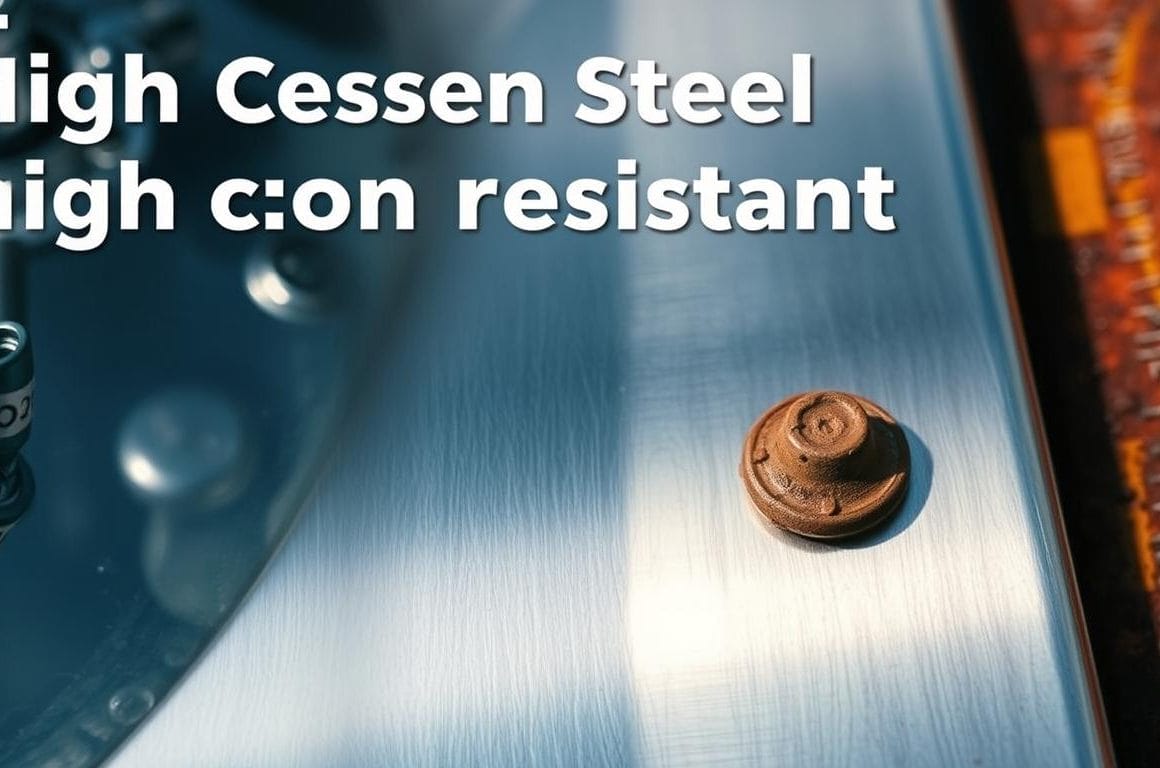
Key Characteristics of Carbon Steel
Carbon steel is known for its carbon steel properties, like strength and hardness. The carbon content affects its strength and how it’s used in different industries. Knowing these differences helps choose the right material for projects.
Strength and Hardness
The carbon content changes the strength and hardness of carbon steel. Low-carbon steels, with up to 0.3% carbon, are softer and easier to work with. High-carbon steels, with up to 2.1% carbon, are stronger but harder to process. This makes high-carbon steel great for tools and parts that need to last long.
Price Points
Carbon steel is often cheaper than stainless steel. Prices vary based on the grade and carbon content. But, carbon steel is usually the more affordable choice for many uses.
Applications in Industry
Carbon steel is used in many areas, like construction, manufacturing, and cars. It’s used for:
- Structural parts like beams and columns
- Strong tools and machinery parts
- Car body panels and frames
- Pipelines and tubing
- Cutting tools and blades
| Type of Carbon Steel | Carbon Content | Common Uses |
|---|---|---|
| Low-Carbon Steel | 0.05% – 0.3% | Automobile body parts, making it easier to weld |
| Mild Steel | 0.3% – 0.6% | Structural work, general fabrication |
| High-Carbon Steel | 0.6% – 2.1% | Cutting tools, dies, springs |
Comparative Analysis: Stainless Steel vs Carbon Steel
Carbon steel and stainless steel have key differences that affect how they are used. Carbon steel is divided into four types based on carbon content. These are low-carbon, medium-carbon, high-carbon, and ultra-high carbon steel.
- Low-carbon steel (0.05% to 0.15%) is very ductile. It’s great for making stamping machines and auto parts.
- Medium-carbon steel (0.1% to 1.29%) has a good mix of ductility and strength. It’s used in tanks and structures.
- High-carbon steel (0.1% to 3.4%) is hard and often used for knives.
- Ultra-high carbon steel (up to 4.0%) is very strong but also very brittle.
Stainless steel, with at least 10.5% chromium, has different types. These include austenitic, ferritic, martensitic, duplex, and precipitation hardening. Each type has its own special properties.
- Austenitic stainless steel has 18% chromium and 8% nickel. It’s very resistant to corrosion.
- Ferritic stainless steel (12%-30% chromium) is corrosion-resistant and magnetic.
- Martensitic stainless steel (11.5%-18% chromium) is very strong. It’s used in jet engines.
- Duplex stainless steel has high strength and corrosion resistance. It’s used in demanding industries.
- Precipitation hardening stainless steel has high strength after heat treatment. It includes elements like aluminum.
Stainless steel is better at resisting corrosion because it forms a protective layer. Carbon steel doesn’t have this layer. So, it’s more prone to rust and corrosion unless treated.
High-carbon steel is very strong and hard but not ductile or weldable. Stainless steel is not as strong but is more ductile and weldable. This makes stainless steel a better choice for many applications.
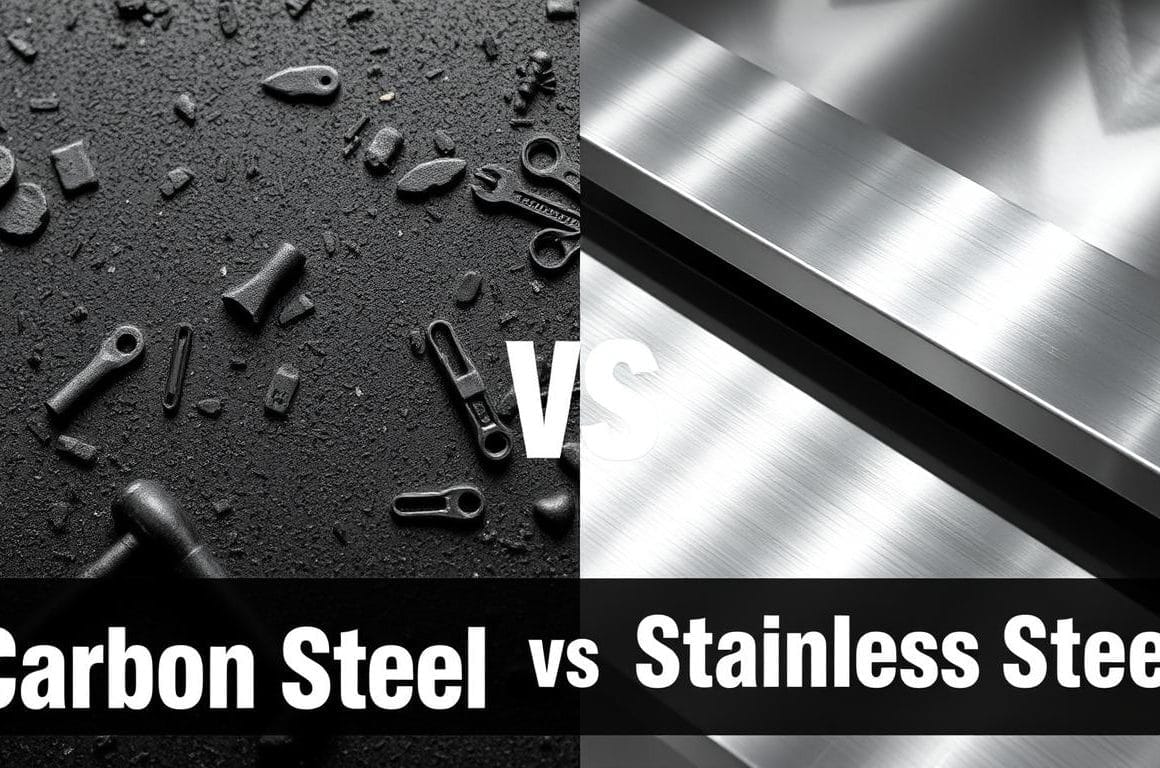
Applications of Carbon Steel
Carbon steel is very important in many industries because it’s strong and versatile. It’s a top choice for construction and manufacturing. Its uses make it a reliable option in many areas of life.
Common Uses in Construction
In construction, carbon steel is key for making strong parts. It’s strong and affordable, perfect for:
- Structural beams
- Pipes and tubing
- Reinforcement for concrete structures
- Steel frames for buildings and bridges
It’s vital for keeping buildings and bridges safe and stable. This makes it a top pick for big projects.
Manufacturing and Industrial Applications
In manufacturing, carbon steel is used for products that need to be hard and durable. It’s used for:
- Tools and machinery
- Automotive parts
- Heavy-duty equipment
- Industrial blades and cutting tools
Its uses show how important it is for making tough products. These products can handle the tough demands of industrial settings.
| Industry | Application | Examples |
|---|---|---|
| Construction | Structural members | Beams, columns, and frames |
| Manufacturing | Tools and machinery | Cutting tools, automotive parts |
| Automotive | Structural components | Chassis, body panels |
| Industrial | Heavy-duty equipment | Machinery casings, pipelines |
Carbon steel’s uses show its crucial role in many fields. It’s key for modern infrastructure and manufacturing.
Applications of Stainless Steel
Stainless steel is great in many fields because it doesn’t rust and is clean. It’s used in many areas for both looks and function. Let’s see why stainless steel is a top choice in many industries.
Use in Medical Instruments
Stainless steel is key in healthcare. It’s used in surgical tools, implants, and more because it doesn’t corrode. This makes it easy to clean and keeps tools working well for a long time.
Common Kitchen Products and Cookware
In kitchens, stainless steel is everywhere. It’s in pots, pans, and utensils because it’s easy to clean and doesn’t rust. It also looks good, making kitchens nicer for everyone.
Industries Utilizing Stainless Steel
Many industries use stainless steel. Cars use it for strong parts that last long. Food and drink places use it for clean storage and machines. Aerospace and building also use it for its strength and dependability.

Stainless Steel or Carbon Steel: Best Choice for Your Project
Choosing between stainless steel and carbon steel depends on your project’s needs. Each material has its own benefits based on the application, environment, and budget.
In places with moisture or corrosive elements, stainless steel is often the best choice. It has at least 10.5% chromium, which fights corrosion well. This makes it great for the medical and food industries, where cleanliness and durability matter. Stainless steel also looks good for a long time.
Carbon steel, however, is best for projects that need strength. It has different carbon levels, from low to ultra-high, making it hard and tough. It’s often used in construction and heavy machinery. Even though it can rust, its strength is worth it, and it’s cheaper than stainless steel.
Deciding between stainless steel and carbon steel needs careful thought. You must consider the project’s needs, like strength and upkeep. For more info, check out here. The right choice depends on how well each material fits the project’s purpose.
Cost Considerations
When choosing between stainless steel and carbon steel, knowing their prices is key. Stainless steel costs more because it’s durable and resists corrosion better. It’s important to think about both the initial cost and ongoing expenses.
Budgeting for Stainless Steel
The price of stainless steel changes based on its type and what’s in it. Elements like chromium and nickel make it strong and resistant to corrosion. This means stainless steel can handle tough environments.
When planning your budget for stainless steel, remember:
- Initial material cost: It’s usually pricier than carbon steel.
- Long-term savings: Its durability might mean you replace it less often.
- Maintenance costs: It’s cheaper in places where you need something that won’t rust.
Budgeting for Carbon Steel
Carbon steel is a more affordable choice with a lower starting price. Its cost depends on how much carbon it has. Low-carbon steel is the cheapest and easiest to work with.
When budgeting for carbon steel, consider these points:
- Cost-effectiveness: It’s cheaper upfront, making it great for many uses.
- Durability considerations: It’s not as good against corrosion but works well in some structures.
- Maintenance: It needs care to avoid rust, which could add to long-term costs.
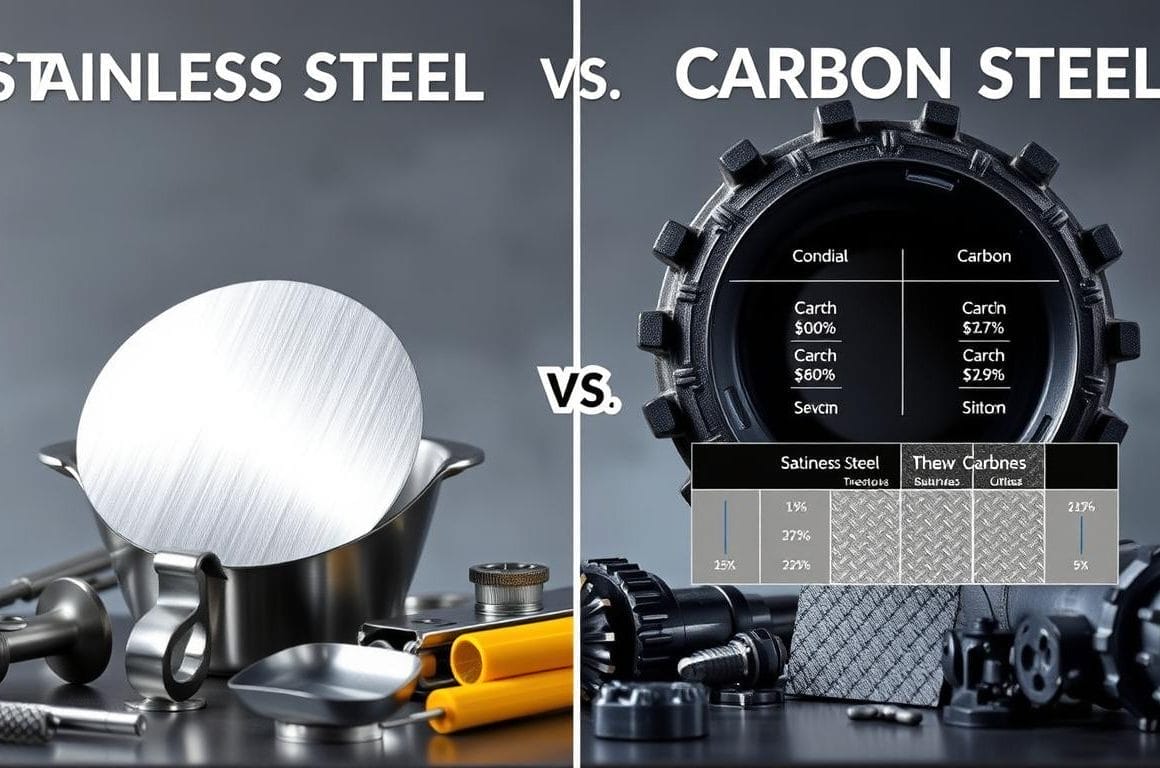
| Material Type | Cost Range (per ton) | Corrosion Resistance | Durability |
|---|---|---|---|
| Stainless Steel | $2,500 – $5,000 | High | Excellent |
| Carbon Steel | $600 – $1,200 | Low | Good |
In summary, comparing the costs of stainless steel and carbon steel needs a careful look at both immediate and future expenses.
Maintenance and Care for Carbon Steel
Caring for carbon steel cookware is key to its long life and great cooking. It’s important to keep it in good shape to avoid rust. This guide will help you with seasoning, cleaning, and long-term care.
Seasoning and Cleaning
Seasoning a carbon steel pan is the first step to a nonstick surface. You need to apply a thin layer of oil like canola or sunflower. Then, heat the pan to make the oil polymerize.
Over time, this oil forms layers that make cooking better.
- For initial seasoning, apply about ¼ teaspoon of oil and heat the pan on the stove or in the oven.
- After cooking, clean the pan by wiping away food residue with a paper towel.
- If food sticks, loosen it with water or a mixture of coarse salt and oil.
- Remove rust with steel wool and a paste made from baking soda and vinegar.
- Avoid dish soap and dishwashers, as they strip the seasoning and may lead to damage.
Long-Term Care Tips
To keep your cookware in top shape, follow these tips:
- Store the pan completely dry to prevent rust, particularly in humid conditions.
- Periodically re-season the pan to maintain its protective patina and cooking properties.
- Avoid cooking acidic foods, as they can erode the seasoning.
- For stubborn messes, boiling water can be used, or more aggressive scrubbing may be necessary.
- Continue to develop the seasoning over time, noting that a darker patina indicates proper use and care.
By following these care tips, you can keep your carbon steel cookware in great shape. This way, you’ll enjoy cooking for years to come.
Maintenance and Care for Stainless Steel
Proper maintenance stainless steel means regular cleaning and care. This keeps it durable and shiny. Unlike carbon steel, stainless steel is easy to care for. It lasts long if you take good care of it. This section will cover cleaning methods and why regular maintenance is key.
Cleaning Methods
Cleaning stainless steel needs special methods for different dirt types. Start with warm or hot water and mild detergent. Make sure to rinse well to get rid of any leftover soap. For stubborn stains, use specific cleaners:
- Dirt: Warm or hot water with detergent works well. Stay away from carbon steel brushes or steel wool.
- Inks: Use solvents like xylene or alcohol, then rinse with warm water.
- Oils: Isopropyl alcohol is good for oil stains. Use harsher solvents with caution.
- Adhesives: Alcohol or mineral spirits work best, followed by glass cleaner.
- Water Scale: Vinegar and warm water can help with scaling.
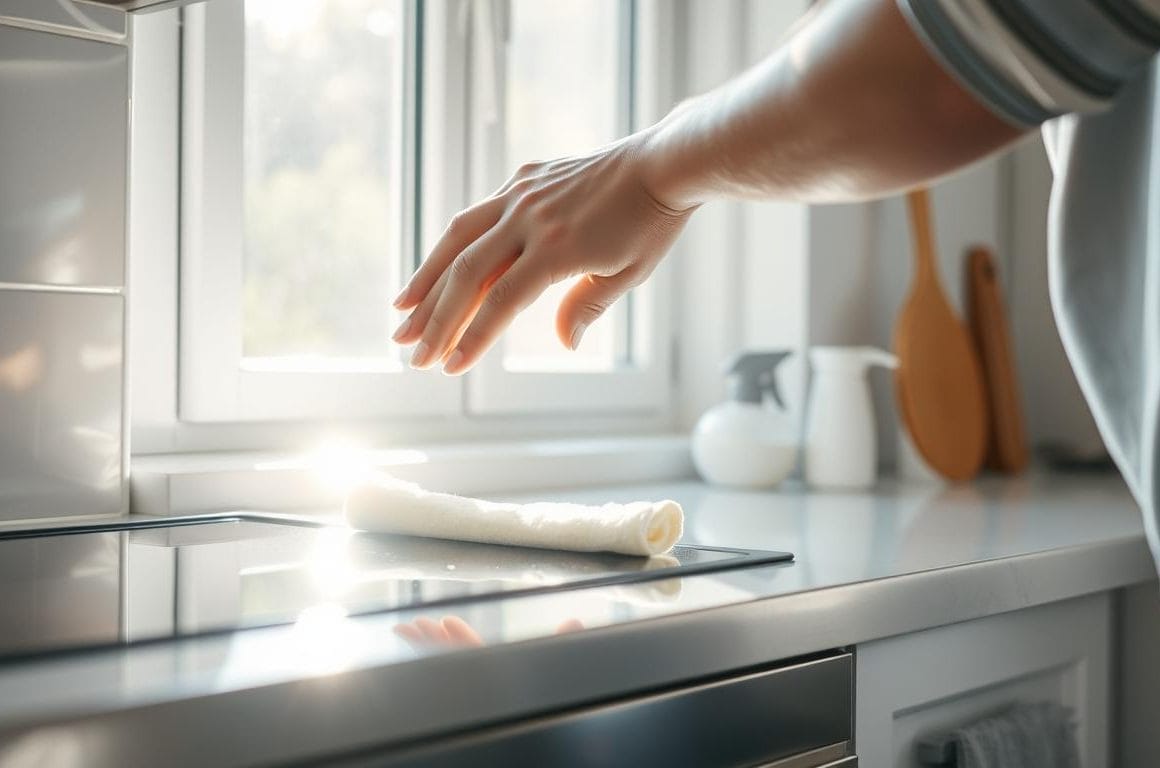
It’s important to clean up dirt and stains right away to avoid corrosion. Things like free iron particles and chlorides can harm the surface. Regular checks every six months help catch corrosion early.
Durability Over Time
The life of stainless steel depends on how well you care for it. In places with salt or de-icing salts, cleaning often is crucial. Brushed stainless steel looks nice but can trap chloride ions, leading to corrosion if not cleaned right. Use stainless steel tools and avoid carbon steel to prevent contamination.
For serious damage, like rust, you might need a pro. But for small stains or tarnish, the right cleaners and polish can fix it. Always follow safety rules, like wearing gloves when using chemicals, to keep maintenance safe and effective.
By using these cleaning tips and sticking to a regular maintenance plan, you can keep stainless steel looking and working great. This is true for both kitchen and industrial uses, for many years. Regular cleaning not only preserves the shine but also helps maintain the durability and functionality of the material. Pay special attention to stainless steel oven features, as these often require extra care to prevent buildup and ensure optimal performance. By addressing minor issues promptly and following these guidelines, you can extend the lifespan of your stainless steel appliances and equipment.
Environmental Considerations
The growing use of stainless steel is linked to its eco-friendly nature. It’s made from recycled materials, which cuts down on raw material needs. This also lessens the harm caused by carbon steel production.
The stainless steel industry keeps getting better, using less energy to make it. It also lasts longer because of its corrosion resistance. This means less money spent on upkeep, beating out carbon steel and others like aluminum and iron.
Stainless steel is also strong yet light, making it efficient in many uses, like wind turbines. High-strength duplex stainless steels are especially good for withstanding wear and tear. Even tidal power systems use stainless steel for its seawater durability.
Over half of all stainless steel today comes from recycled materials. This shows it’s fully recyclable without losing quality. Recycling in the industry helps the environment and uses resources wisely. Companies like Ulbrich Specialty Strip Mill are working to reduce waste by recycling scrap and packaging.
Stainless steel is becoming the go-to for projects that care about the planet. It’s a better choice than carbon steel, which can harm the environment more. Choosing stainless steel shows we’re moving towards greener construction and manufacturing.
Final Thoughts on Choosing the Right Steel
When deciding between stainless steel and carbon steel, it’s important to think about what you need. You should consider things like how well it resists corrosion, its strength, cost, and how easy it is to maintain. Stainless steel has at least 10.5% chromium, which makes it great at fighting rust. This is especially useful in places where there’s a lot of moisture.
Carbon steel, on the other hand, has different uses based on its carbon content. Low-carbon steel, with 0.05% to 0.15% carbon, is often used in building materials. High-carbon steel, with up to 3.4% carbon, is used in tools that need to be very strong. Knowing what your project needs will help you choose the right steel. For more information, check out this resource.
Making the right choice comes from understanding what each steel type can do. Whether you pick stainless steel or carbon steel, make sure it fits your project’s needs. Doing your homework is key to finding steel that works well and fits your budget.
FAQ
What are the main differences between stainless steel and carbon steel?
In which applications is stainless steel preferred?
What types of carbon steel are available?
How do maintenance requirements differ between stainless steel and carbon steel?
Why is stainless steel more expensive than carbon steel?
Can carbon steel be used in outdoor projects?
What are the environmental considerations of using stainless steel?
How do the strength and brittleness of carbon steel compare to stainless steel?
Source Links
- https://industrialmetalservice.com/metal-university/carbon-steel-vs-stainless-steel/?srsltid=AfmBOorVgFOqRWy4QV3f4zHuoAZet–f5TmMXCqCkDV2iDlxfTDzh-6r
- https://threedmetals.com/blog/a-guide-to-steel-grades-low-carbon-high-carbon-and-stainless-steel/
- https://industrialmetalservice.com/metal-university/carbon-steel-vs-stainless-steel/?srsltid=AfmBOoqfgnn5suLxC5PHIqdKLQ94K-U75lrcfEHTLEpqJ4PcHWrgROYJ
- https://markforged.com/resources/blog/carbon-steel-vs-stainless-steel
- https://www.azom.com/article.aspx?ArticleID=23145
- https://monroeengineering.com/blog/whats-the-difference-stainless-steel-vs-carbon-steel/
- https://www.appmfg.com/blog/stainless-steel-vs-carbon-steel.-whats-the-big-deal
- https://www.twi-global.com/technical-knowledge/faqs/carbon-steel-vs-stainless-steel
- https://www.metalsupermarkets.com/difference-between-carbon-stainless-steel/
- https://www.meadmetals.com/blog/stainless-steel-vs-carbon-steel
- https://www.industrialmetalsupply.com/blog/carbon-steel-vs-stainless-steel
- https://www.unifiedalloys.com/blog/stainless-vs-carbon-steel
- https://www.thyssenkrupp-materials.co.uk/l/carbon-steel-vs-stainless-steel
- https://industrialmetalservice.com/metal-university/carbon-steel-vs-stainless-steel/?srsltid=AfmBOopRuNWhWa7CUTpzDGz2KEZILTUs2XaZvp709RJg91Pgy-TRmXLw
- https://inspenet.com/en/articulo/ndt-on-carbon-steel-vs-stainless-steel/
- https://www.kloecknermetals.com/blog/when-to-use-carbon-steel-vs-stainless-steel/
- https://industrialmetalservice.com/metal-university/carbon-steel-vs-stainless-steel/?srsltid=AfmBOortlctcLfA-8k77zsF6yCjrup-T06WYwTMUXdK-R0VBK2fDlC-5
- https://americanindust.com/blog/blog-common-applications-for-carbon-steel-stainless-steel-and-non-ferrous-metals/
- https://industrialmetalservice.com/metal-university/carbon-steel-vs-stainless-steel/?srsltid=AfmBOoqdZD0EjapCKLyNYS2V1w7LEM3-Ntu98okgWoEia8mDFEgtph_T
- https://www.ulmaforge.com/en/new/stainless-steel-vs-carbon-steel-a-detailed-comparison/
- https://industrialmetalservice.com/metal-university/carbon-steel-vs-stainless-steel/?srsltid=AfmBOop_fnwrXFjUJi-dQiZbIDkDf3N9K8dCNr5D-hQ31sRdiRZGyw88
- https://www.headsupb2b.com/blog/carbon-steel-vs-stainless-steel
- https://benchmarkabrasives.com/blogs/news/carbon-steel-vs-stainless-steel-the-differences?srsltid=AfmBOoocSo0UaxfaYdwCMZNHR-UtZtVJzZnGLuVjkn_o85tl7t-PY2PC
- https://www.marthastewart.com/8238553/how-care-for-carbon-steel-pan
- https://madeincookware.com/blogs/carbon-steel-care-guide
- https://misen.com/pages/carbon-care
- https://www.reliance-foundry.com/wp-content/uploads/stainless-steel-care-and-maintenance.pdf?srsltid=AfmBOoo5EJS8-qocuhJW-yehhm3wptIgxdv-vyqhMjnW1hIY84nR9s8w
- http://codeblue.com/wp-content/uploads/csc-213_Stainless_Steel_Maintenance.pdf
- https://www.azahner.com/resources/maintenance-and-cleaning-of-stainless-steel
- https://www.unifiedalloys.com/blog/stainless-environmental-benefits
- https://www.ulbrich.com/blog/stainless-sustainability-the-circular-economy-of-metal/
- https://industrialmetalservice.com/metal-university/carbon-steel-vs-stainless-steel/?srsltid=AfmBOopYaUUHMHUs-B6gNhs1CqDE-XSMRuRfucH-i_XiZED_ctVeOdSa
- https://endura-steel.com/how-to-choose-the-right-steel-grade-for-your-project/
- https://therationalkitchen.com/carbon-steel-vs-stainless-steel-pans/


